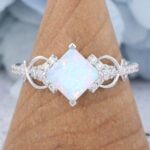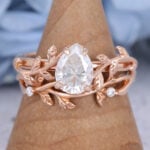Moonstone vs Opal: Discover the Key Differences Before You Buy
Both moonstone and opal are widely used in wedding jewelry because of their beautiful meanings and optical effects. These two gemstones are often confused because of their similar colors. So what are the differences between opal and moonstone? In this article we compare moonstone vs opal stone to help you understand these two precious gemstones before buying.
What is moonstone?
Moonstone, opal-like gemstone, is a mineral composed of sodium-potassium feldspar, which is formed by two components arranged in alternating layers and separated by cooling. This unique structure produces the unique adularescence of moonstone, which is usually bluish-white. Moonstone gemstones are named for this soft halo effect like moonlight.
What Is Opal?
Opal is a hydrated amorphous silica mineral. Unlike moonstone, opal has an irregular internal structure consisting of only nano-scale silicon spheres. Therefore, the diffraction of light here can produce a gorgeous and varied Play of Color, making opal one of the most popular color-changing gemstones.
Moonstone and Opal Types and Colors
Moonstone types and color characteristics
White Moonstone: Milky white or light gray base with soft blue-white glow; opalescent moonstone is most common.
Rainbow Moonstone: Transparent to milky base with rainbow-like flashes—blue, purple, orange—dreamy and lively.
Gray Moonstone: Smoky or dark gray with subtle blue or silver sheen, mysterious vibe.
Peach Moonstone: Warm orange-pink hue, soft shine, gentle and feminine.
Green Moonstone: Light green or blue-gray, rare, symbolizes calm and healing.
Opal types and color characteristics
White Opal: Milky or ivory base, soft yet bright fire; classic and popular.
Black Opal: Dark to black base with vivid color play; rarest and most valuable.
Crystal Opal: Clear or translucent, lively fire, highly light-reactive.
Fire Opal: Red, orange, yellow hues; bright body color, some with fire play.
Boulder Opal: Fire embedded in host rock, natural patterns; mostly from Australia.
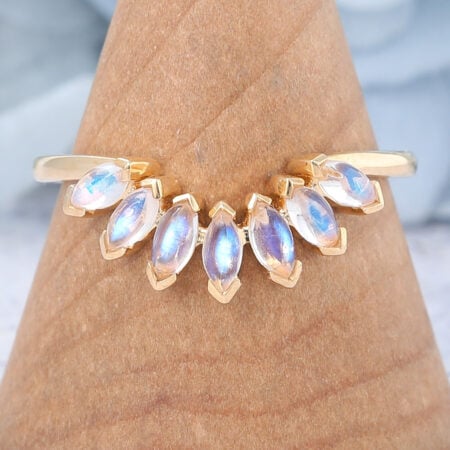
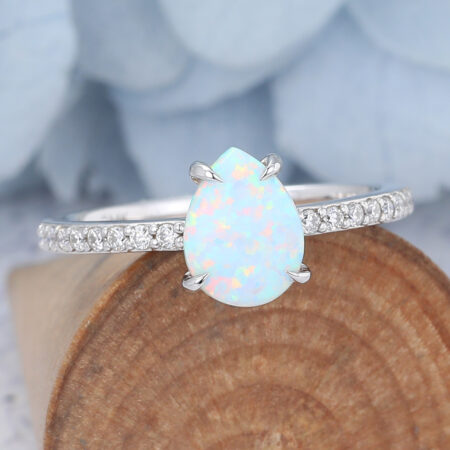
Moonstone vs Opal: Origin and History
Moonstone
Moonstone can be traced back to ancient India and the Roman Empire. In ancient India and Rome, moonstone was considered a stone with protective effects and helpful for meditation, and was of great meaning. The earliest regions where moonstone was discovered were Sri Lanka and India, and these two countries are still important sources of high-quality moonstone now.
Opal
The earliest historical records of opal can be traced back to the Mesopotamian civilization in 4000 BC. Because of its colorful and changing colors, it symbolizes a collection of various gemstones. The earliest opal mining in history was in the present-day Slovakia region, which belonged to the Roman Empire at that time. Later, Australia replaced Europe and became the most important opal producing country today.
Moonstone vs Opal: Visual Differences
Moonstone
The internal structure of moonstone is relatively clean and transparent. When the light shines on it, a soft blue-white halo will slide on the surface of the moonstone. The luster is usually restrained and soft, full of mystery. The overall texture is soft, transparent or translucent.
Opal
Opal often has natural textures or impurity inclusions, which visually has a more natural and primitive artistic sense. When light shines on opal, the inside of the gemstone keeps jumping and presenting changing rainbow-colored flashes. This flash is bright and varied in color and has a more visual impact.
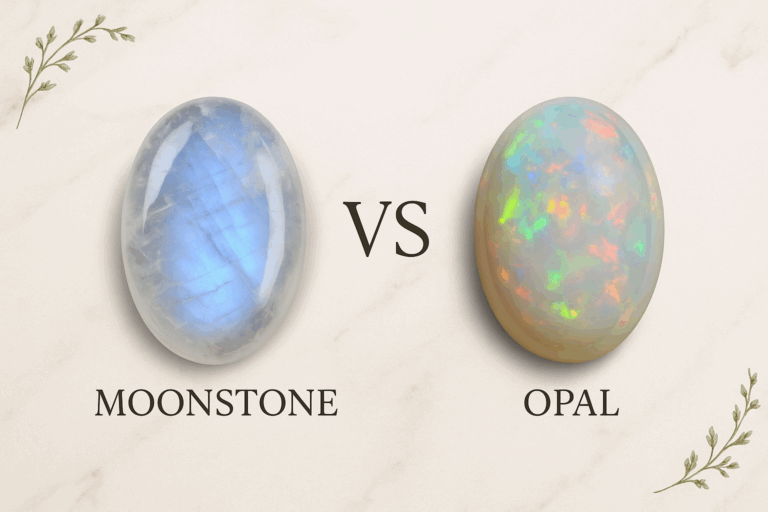
Moonstone vs Opal: Symbolism and Metaphysical Properties
Moonstone
Moonstone meaning is deeply connected to intuition, emotional healing, and new beginnings. Symbolizing the moon and feminine energy, it supports inner growth and balance. Its metaphysical properties include enhancing psychic abilities, calming stress, and promoting emotional clarity, making it ideal for those seeking spiritual insight and harmony.
Opal
Opal meaning represents creativity, inspiration, and emotional amplification. Symbolizing hope and purity, opal’s metaphysical properties include stimulating originality, enhancing imagination, and encouraging emotional expression. It is believed to strengthen one’s connection to the subconscious, helping wearers embrace change and personal transformation with confidence.
Moonstone vs Opal: Durability and Hardness
Moonstone
Moonstone has a Mohs hardness of 6 to 6.5, offering balanced durability for jewelry. With proper care and thoughtful settings, it maintains its beauty well and is ideal for special occasion pieces.
Opal
Opal rates 5.5 to 6.5 in hardness and shines brightest with mindful handling. When set in protective designs, it can be a stunning centerpiece, perfect for those who appreciate delicate elegance and vivid color play.
Moonstone vs Opal: Price and Value Comparison
Moonstone
Moonstone is not a very rare gemstone, but its spiritual meaning and unique light effect make it have a stable value. Common white moonstone is moderately priced and is an affordable gemstone for the public; but varieties with high transparency, strong blue flashes, or even cat’s eye or rainbow light are relatively rare, especially blue moonstone from Sri Lanka. The value of high-quality blue moonstone gemstone is about $50-$300 per carat, and rare rainbow moonstone can even reach $500 per carat.
Opal
The rarity of opal leads to greater price fluctuations. Ordinary white opal is more common, while fire opal (orange-red), black opal (dark body color with colorful flames), and crystal opal (high transparency) are rare varieties. Ordinary opal gemstone value ranges from $20-$200 per carat, while top-grade black opal or fire opal can be as high as $1000-$10000 per carat.
The Birthstone Connection: Understanding Moonstone and Opal
Moonstone
Moonstone is recognized as one of the modern birthstones for June, alongside pearl and alexandrite. It symbolizes new beginnings, intuition, and emotional balance, making it a meaningful choice for those born in June who seek calmness and spiritual growth.
Opal
Opal is the traditional birthstone for October, celebrated for its unique play-of-color and vibrant beauty. It represents creativity, inspiration, and emotional expression, perfectly reflecting the dynamic and imaginative nature of October-born individuals.
Conclusion
Moonstone vs Opal each offers unique appeal. No matter which gemstone you choose, Amandafinejewelry offers you a range of styles of moonstone and opal rings.
FAQs About Moonstone vs Opal
Where is moonstone found? Is moonstone opal? Is moonstone good for Leos?
Moonstone is mainly found in Sri Lanka, India, and Madagascar. It is not opal—moonstone and opal are different gemstones with unique structures and appearances. Moonstone is considered beneficial for Leos, as it helps balance their strong emotions and enhances intuition.
What color is moonstone? What does a moonstone look like?
Moonstone comes in shades like white, peach, gray, and rainbow, often showing a soft blue glow called adularescence. It has a smooth, translucent appearance. For those drawn to shimmering stones, moonstone is one of the gemstones similar to opal in visual appeal.
How to identify raw opal and moonstone?
Raw moonstone shows a subtle shimmer and is often milky or gray with a layered structure. Raw opal may display flashes of color (play-of-color) even in rough form and often has a waxy luster. Each has a distinct texture and internal glow.
How to tell if a moonstone is real? Do moonstones crack easily?
A real moonstone will have natural inclusions and a glowing light effect called adularescence when moved under light. Due to their 6–6.5 Mohs hardness, they can crack or chip if struck, so protective settings and careful wear are recommended.
How much is moonstone worth? Are moonstones expensive?
Moonstones are generally affordable. Its price ranges from $10 to $300 per carat, depending on clarity, color, and sheen quality.
What color is opal? What does opal represent?
Opal comes in a range of colors—white, black, blue, orange, and more—often with striking color flashes. Opal represents creativity, emotional expression, and inspiration, making it a powerful symbol of imagination and individuality.
What does opal represent? How much is opal worth?
Opal meaning is tied to creativity, inspiration, and emotional freedom, often symbolizing imagination and transformation. Opal’s value varies widely, from around $20 per carat for common types to over $5,000 per carat for high-quality black or fire opals.


